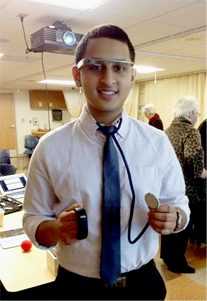15 Awe-Inspiring Healthcare Education Tools of the Future
February 28, 2014
 Oooohs and ahhhhhs filled the room when Robbie Melton, PhD, Associate Vice Chancellor for the Tennessee Board of Regents, visited the College of Nursing and Health Professions last month. With an invitation from Dean Gloria Donnelly, Melton’s goal was to show us some of the most awe-inspiring new mobile technologies and apps that can be infused into college level curricula in the health professions.
Oooohs and ahhhhhs filled the room when Robbie Melton, PhD, Associate Vice Chancellor for the Tennessee Board of Regents, visited the College of Nursing and Health Professions last month. With an invitation from Dean Gloria Donnelly, Melton’s goal was to show us some of the most awe-inspiring new mobile technologies and apps that can be infused into college level curricula in the health professions.
During her visit, Melton brought along a series of diagnostic devices and several ipads, each loaded with apps that have the potential to truly change how healthcare education is delivered. Here are some of the new developments she introduced to the group.
- The infamous Google Glass could someday soon be used by surgeons in the OR to transmit video of live surgeries to where medical students can view the procedures in real-time, a concept that could be applied across many different disciplines.
- Forget the traditional shirtless procedure with electrode stickers, tangled wires, and clunky machines. There is now a bracelet that will conduct an electrocardiogram (EKG) test.
- Google announced recently that they have developed a contact lens that can read a person’s blood sugar level.
- There are now electronic tattoos that will check the wearer’s vital signs.
- Prognosis is an app that makes “clinical case studies fun and simple!” by asking students to answer problem-based learning questions. It also lets their instructors provide feedback to their answers in real-time.
- You may be one Amazon purchase away from healthier eating habits. The Bluetooth-enabled Smart Fork will light up or vibrate to let you know when you’re eating too fast.
- An app called Heart Pro III is perfect for studying the way the human heart works. It lets you zoom and rotate a three-dimensional animated model of the human heart, and take screenshots and notes. Knee Pro III works the same way.
- New cordless blood pressure cuffs light up with different colors to alert the wearer if they are in or out of their target pressure range. These devices are ideal for home use.
- An app called Eye Decide will use your tablet’s camera feature to show you what it’s like to view the world with cataracts and other eye problems.
- iDance is an app that shows users what muscles are engaged during different dance movements.
- Similarly, the app iMuscle demonstrates what physical exercises will engage specific muscle groups.
- If you’re a hypochondriac, you may want to skip this next new app. HealthMap uses the GPS on your phone or tablet to show what contagious diseases have been reported within a 50-mile radius of your current position, using the CDC and other sources for up to date information.
- Have a student or patient who uses sign language to communicate? Speak or type a sentence into the Sign4Me app and an avatar will sign your sentence.
- You thought smartboards were an impressive addition to the classroom? Well, the ubi Integrative Wall is a device that will turn any surface into a smartboard.
- Finally, LeapMotion’s AirSpace technology lets you manipulate what your students see on the screen using hand gestures in mid-air.
“Educators must recognize the impact of mobile devices as an 'on-demand and within your hands' tool that can enhance teaching, learning, and the workforce using appropriate educational content, apps, and accessories. Yes, as the saying goes- there is an [educational] app for that!” Melton said.
Melton created the Mobile App Education and Workforce Resource Center, where over 50,000 apps have been aligned with over 95 subject areas from Pre-K to PhD level learning. Melton is an internationally recognized expert, having received numerous national awards for her expertise in teaching and technology.